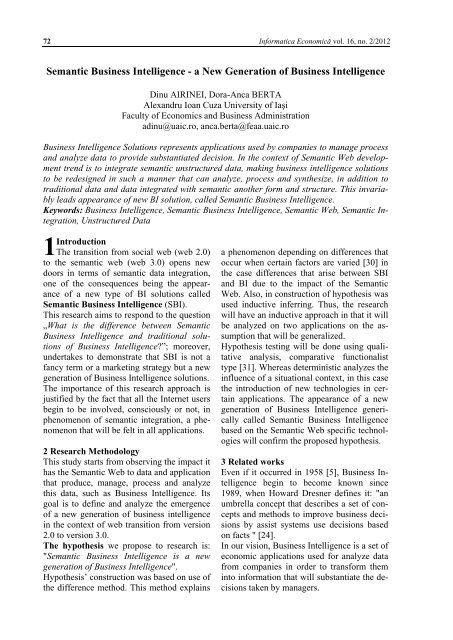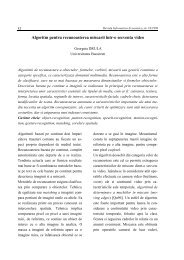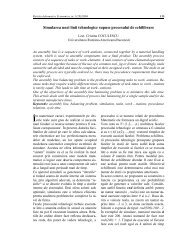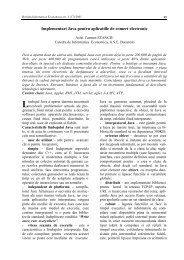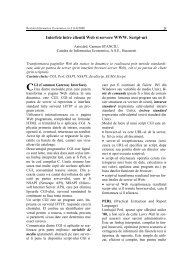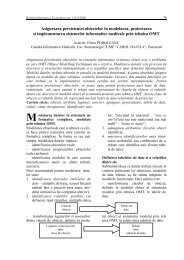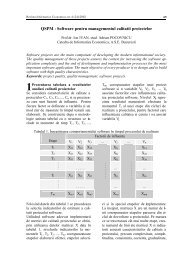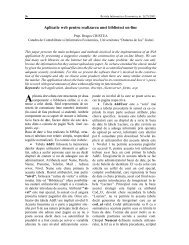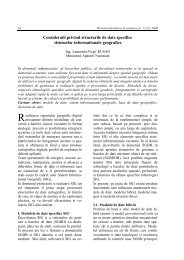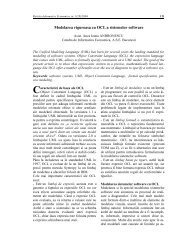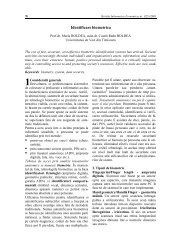Semantic Business Intelligence - Informatica Economica
Semantic Business Intelligence - Informatica Economica
Semantic Business Intelligence - Informatica Economica
You also want an ePaper? Increase the reach of your titles
YUMPU automatically turns print PDFs into web optimized ePapers that Google loves.
72 <strong>Informatica</strong> Economică vol. 16, no. 2/2012<br />
<strong>Semantic</strong> <strong>Business</strong> <strong>Intelligence</strong> - a New Generation of <strong>Business</strong> <strong>Intelligence</strong><br />
Dinu AIRINEI, Dora-Anca BERTA<br />
Alexandru Ioan Cuza University of Iaşi<br />
Faculty of Economics and <strong>Business</strong> Administration<br />
adinu@uaic.ro, anca.berta@feaa.uaic.ro<br />
<strong>Business</strong> <strong>Intelligence</strong> Solutions represents applications used by companies to manage process<br />
and analyze data to provide substantiated decision. In the context of <strong>Semantic</strong> Web development<br />
trend is to integrate semantic unstructured data, making business intelligence solutions<br />
to be redesigned in such a manner that can analyze, process and synthesize, in addition to<br />
traditional data and data integrated with semantic another form and structure. This invariably<br />
leads appearance of new BI solution, called <strong>Semantic</strong> <strong>Business</strong> <strong>Intelligence</strong>.<br />
Keywords: <strong>Business</strong> <strong>Intelligence</strong>, <strong>Semantic</strong> <strong>Business</strong> <strong>Intelligence</strong>, <strong>Semantic</strong> Web, <strong>Semantic</strong> Integration,<br />
Unstructured Data<br />
1<br />
Introduction<br />
The transition from social web (web 2.0)<br />
to the semantic web (web 3.0) opens new<br />
doors in terms of semantic data integration,<br />
one of the consequences being the appearance<br />
of a new type of BI solutions called<br />
<strong>Semantic</strong> <strong>Business</strong> <strong>Intelligence</strong> (SBI).<br />
This research aims to respond to the question<br />
„What is the difference between <strong>Semantic</strong><br />
<strong>Business</strong> <strong>Intelligence</strong> and traditional solutions<br />
of <strong>Business</strong> <strong>Intelligence</strong>?”; moreover,<br />
undertakes to demonstrate that SBI is not a<br />
fancy term or a marketing strategy but a new<br />
generation of <strong>Business</strong> <strong>Intelligence</strong> solutions.<br />
The importance of this research approach is<br />
justified by the fact that all the Internet users<br />
begin to be involved, consciously or not, in<br />
phenomenon of semantic integration, a phenomenon<br />
that will be felt in all applications.<br />
2 Research Methodology<br />
This study starts from observing the impact it<br />
has the <strong>Semantic</strong> Web to data and application<br />
that produce, manage, process and analyze<br />
this data, such as <strong>Business</strong> <strong>Intelligence</strong>. Its<br />
goal is to define and analyze the emergence<br />
of a new generation of business intelligence<br />
in the context of web transition from version<br />
2.0 to version 3.0.<br />
The hypothesis we propose to research is:<br />
"<strong>Semantic</strong> <strong>Business</strong> <strong>Intelligence</strong> is a new<br />
generation of <strong>Business</strong> <strong>Intelligence</strong>".<br />
Hypothesis’ construction was based on use of<br />
the difference method. This method explains<br />
a phenomenon depending on differences that<br />
occur when certain factors are varied [30] in<br />
the case differences that arise between SBI<br />
and BI due to the impact of the <strong>Semantic</strong><br />
Web. Also, in construction of hypothesis was<br />
used inductive inferring. Thus, the research<br />
will have an inductive approach in that it will<br />
be analyzed on two applications on the assumption<br />
that will be generalized.<br />
Hypothesis testing will be done using qualitative<br />
analysis, comparative functionalist<br />
type [31]. Whereas deterministic analyzes the<br />
influence of a situational context, in this case<br />
the introduction of new technologies in certain<br />
applications. The appearance of a new<br />
generation of <strong>Business</strong> <strong>Intelligence</strong> generically<br />
called <strong>Semantic</strong> <strong>Business</strong> <strong>Intelligence</strong><br />
based on the <strong>Semantic</strong> Web specific technologies<br />
will confirm the proposed hypothesis.<br />
3 Related works<br />
Even if it occurred in 1958 [5], <strong>Business</strong> <strong>Intelligence</strong><br />
begin to become known since<br />
1989, when Howard Dresner defines it: "an<br />
umbrella concept that describes a set of concepts<br />
and methods to improve business decisions<br />
by assist systems use decisions based<br />
on facts " [24].<br />
In our vision, <strong>Business</strong> <strong>Intelligence</strong> is a set of<br />
economic applications used for analyze data<br />
from companies in order to transform them<br />
into information that will substantiate the decisions<br />
taken by managers.
<strong>Informatica</strong> Economică vol. 16, no. 2/2012 73<br />
Along the time, attempting to keep up with<br />
technology, <strong>Business</strong> <strong>Intelligence</strong> passed<br />
through several phases, becoming from operational<br />
BI real-time BI [26], adding socialization<br />
modules [6], and expanding its functionality<br />
to be used by mobile phones, turning to<br />
Mobile BI [1] and now by adding new semantic<br />
technologies becomes <strong>Semantic</strong><br />
<strong>Business</strong> <strong>Intelligence</strong>.<br />
Given that the subject addressed is a relatively<br />
new, literature is rather poor in this area of<br />
<strong>Semantic</strong> <strong>Business</strong> <strong>Intelligence</strong>. Internationally,<br />
the field began to attract the interest of<br />
researchers since 2006 due to research projects<br />
to find viable solutions for the integration<br />
of semantic technologies in <strong>Business</strong> <strong>Intelligence</strong><br />
solutions.<br />
MUSING, a European research and development<br />
project funded by FP6 and passed off<br />
in 2006-2010, had as mission developing a<br />
new generation of <strong>Business</strong> <strong>Intelligence</strong>. The<br />
goal of this project was to support research<br />
that aimed to develop tools and modules for<br />
BI which integrate elements of semantic web<br />
and human language processing technologies<br />
to improve knowledge acquisition of BI solutions<br />
[16].<br />
This project has managed work up an interest<br />
to some researchers, who treated <strong>Semantic</strong><br />
BI, but their number was quite limited compared<br />
to the area to be exploited, and their interest<br />
after the project decreased significantly.<br />
Fortunately, this mega-project finds its continuity<br />
in projects funded by FP7 Cubist<br />
(Combining and Uniting <strong>Business</strong> <strong>Intelligence</strong><br />
with <strong>Semantic</strong> Technologies).<br />
CUBIST is a project funded by the European<br />
Commission on the priority axis "Intelligent<br />
In-Formation Management" and will take<br />
place between 2010 and 2013. The major pillars<br />
are represented by semantic technologies,<br />
business intelligence and Visual Analytics,<br />
and as areas of interest are covered: market<br />
and competitive intelligence, computational<br />
biology / biomedical informatics and<br />
control centers operations [36].<br />
What makes this project truly extraordinary<br />
is combination between theory and practice:<br />
researchers receive support and cooperation<br />
from the developers of applications or technologies.<br />
The most important partners in research<br />
work are: SAP as a conceded producer<br />
of BI and Ontotext Lab, a developer of semantic<br />
technologies all too well known. On<br />
the other hand, researchers are selected from<br />
prestigious universities such as Sheffield<br />
Hallam University (England), CENTRAL<br />
Recherché in Paris and Heriot-Watt University<br />
(England).<br />
Expected results of project implementation<br />
aim to incorporate unstructured data into existing<br />
solutions. For this to be possible, researchers<br />
propose that the level of technology<br />
to design new architecture that supports<br />
integration of unstructured data, hence the<br />
need for alloying with specialist manufacturers<br />
of applications.<br />
By consulting the literature, we found that in<br />
Romania there is no post to be treated this<br />
subject. One reason could be related to the<br />
fact that on the market has not been promoted<br />
semantic solutions yet; most manufacturers<br />
are currently working on them. Looking<br />
at things from another angle, the Romanian<br />
companies do not seem interested in semantic<br />
integration of data which they hold.<br />
4 <strong>Semantic</strong> Web– premise of SBI appearance<br />
The <strong>Semantic</strong> Web "was born" as a desideratum<br />
[29]: to have data in a Web defined and<br />
interconnected (linked) in a manner that<br />
computers can be used not only to display<br />
but especially for automation, integration and<br />
reuse of data from various applications.<br />
Berners-Lee's vision about the <strong>Semantic</strong> Web<br />
takes the form of a highly interconnected<br />
network of data that could be easily accessed,<br />
understood and used by any desktop or portable<br />
computer [4].<br />
According to the dictionary [32], the term<br />
"semantic" considered by the light of informatics<br />
is seen as "The theory of a formalized<br />
particular system interpretation by other formalized<br />
system." On the literature [27], [19],<br />
[10] were identified several types of semantics<br />
applied in informatics [27]: real-world<br />
semantics, axiomatic semantic and modeltheoretic<br />
semantics, But any of them would
74 <strong>Informatica</strong> Economică vol. 16, no. 2/2012<br />
be used the purpose will be the same: to provide<br />
a well defined sense to that word /<br />
phrase to which it applies.<br />
The appearance of the <strong>Semantic</strong> Web, also<br />
called Web data [9] promises significant improvements<br />
to the current web. Large amount<br />
of information online, returning irrelevant results<br />
sometimes without accuracy in web<br />
searches and the lack of applications to process<br />
natural language in idea of being understood<br />
by computers are just some of the<br />
shortcomings that experts hope to solve the<br />
<strong>Semantic</strong> Web [34].<br />
- Excessive amount of information - people<br />
create an unimaginably large amount<br />
of digital information, which grows exponentially<br />
in relation with time, reaching<br />
to the size of zettabyte [35] (a<br />
zettabyte represent 10 21 )<br />
- Inefficient search keywords in search engines<br />
– currently, any search information<br />
on the web will not only return the requested<br />
information on a domain, but also<br />
information with the same shape but<br />
different meaning (intended only as a<br />
word or phrase, not meaning, namely semantic)<br />
- Distrust in the veracity – there is no control<br />
mechanism to manage web content<br />
so as may be posted only real information<br />
- Lack of information systems for natural<br />
language processing – currently there is<br />
no common language to be perceived in<br />
the same way as man and computer.<br />
<strong>Semantic</strong> Web is based on XML that develops<br />
new standards coding and description of<br />
data from and about the Web. <strong>Semantic</strong> Web<br />
technologies were developed as a prerequisite<br />
for process automation and improvement<br />
of service enabling data integration and interoperability.<br />
The most known and used are<br />
used technologies semantic RDF Schema,<br />
OWL, SKOS, SPARQL, GRDDL, etc.<br />
In terms of the link between Web and BI, we<br />
can say that Web 1.0 has no influence on<br />
him. Things change, however, with the<br />
emergence of web 2.0 and social networks<br />
when implementing CRM applications BI<br />
modules that include social messages and<br />
posts on social networks to analyze their influence<br />
on companies [6]. We are currently<br />
witnessing the appearance of a new generation<br />
of BI inspired by the <strong>Semantic</strong> Web. In<br />
Figure 2 we tried to plot the relationship between<br />
the two concepts.<br />
Fig. 1. Web impact’s on <strong>Business</strong> <strong>Intelligence</strong><br />
5 SBI – a theoretical approach<br />
The literature by the economic data and<br />
found the web organizations are divided into<br />
three categories. [28]:<br />
- structured data: data companies from<br />
SGBD: ERP, CRM, SCM, BI;<br />
- semistructured data: data from RSS and<br />
XML documents;<br />
- unstructured data: email-uri, blogs, social<br />
networks, mobiles, etc.<br />
<strong>Semantic</strong> <strong>Business</strong> <strong>Intelligence</strong> has emerged<br />
in response to the question „How can be analyzed<br />
unstructured data?” given the fact that<br />
BI solutions currently used applies only to<br />
data that are significantly less structured than<br />
those unstructured - according to Paquet unstructured<br />
data represents about 80% of all<br />
existing data worldwide [18].<br />
Researchers from CUBIST project believe<br />
that to be able to integrate unstructured data
<strong>Informatica</strong> Economică vol. 16, no. 2/2012 75<br />
in its analysis, business intelligence solutions<br />
should be created based on new architectures.<br />
They suggest a possible SBI structure, shown<br />
in figure below.<br />
Hereinafter, we will try to highlight with reference<br />
to this figure we compared differences<br />
appear between BI classic and <strong>Semantic</strong> BI.<br />
Fig. 2. BI versus SBI [37]<br />
a) Data sources: apart from data from<br />
company departments, SBI intends to<br />
analyzing the data found on the web that<br />
relate to the organization, too. For example<br />
may be relevant for a company to<br />
know its<br />
customers Reviews relating to products<br />
tested, or are their preferences for a<br />
product. Also, analysis of unstructured<br />
data gains importance, given that it can<br />
reveal hidden information at first glance,<br />
being useful to BI applications in providing<br />
information about the competition.<br />
b) The storage: in traditional BI, data<br />
warehouses' role is to organize, integrate<br />
and store data from all departments, of<br />
an organization. Inside SBI their place is<br />
taken by triplestores.<br />
The use of triplets is a way that makes<br />
statements about web resources by RFD<br />
consisting of subject, predicate and objects,<br />
where [7]:<br />
- The subject is the resource (identified by<br />
a URI)<br />
- Object is the resource's values<br />
- Predicate – specify the relationship nature<br />
between subject and object<br />
For example in Fig. 2 is rendered a triplet.<br />
Fig. 3. Example of a triplet<br />
c) Data analysis: on traditional BI solutions<br />
the data are analyzed through data<br />
mining tools. Into SBI, data mining tools<br />
will be replaced by FCA (Formal Concept<br />
Analysis). FCA is a method used<br />
for data analysis, knowledge representation<br />
and information management [25]<br />
where the data is structured in units in<br />
the guise of formal abstractions of concepts<br />
of human thought, allowing a<br />
comprehensive and easily understandable<br />
interpretation [8].
76 <strong>Informatica</strong> Economică vol. 16, no. 2/2012<br />
As in the literature will appear design specifications,<br />
models of architecture and structural<br />
schemes of SBI certainly that this list<br />
will grow, but for now it is enough to validate<br />
the proposed hypothesis. As you can see<br />
SBI comes with two new technologies, and<br />
Formal Concept Analysis triplestores, unprecedented<br />
in traditional BI.<br />
6 SBI market<br />
<strong>Business</strong> <strong>Intelligence</strong> <strong>Semantic</strong> Model,<br />
produced by Microsoft, is the first BI solution<br />
on the market that tries to integrate semantic<br />
data. According to market’s data [22]<br />
published by the prestigious company Gartner,<br />
in 2011 Microsoft ranked the five most<br />
popular buyers of BI, with a percentage of<br />
9% which means 1.05 million dollars from<br />
total sales of BI, in these circumstances the<br />
appearance on the market with a semantic solution<br />
is inspired and strategically chosen.<br />
Fig. 4. <strong>Semantic</strong> <strong>Business</strong> <strong>Intelligence</strong> Model [11]<br />
In this solution, there is a layer of metadata<br />
that describes the concepts (entities) and<br />
connections (relationships) between them.<br />
This layer was thought by developers of BI<br />
solution to be user-oriented [23], in that it<br />
shows what can they gain significance, for<br />
example it shows and what are the tables and<br />
relationships in the real world.<br />
One of semantic solutions Microsoft is<br />
PowerPivot, which is nothing but a collection<br />
of applications and integrated into Excel<br />
2010 and SharePoint 2010. The novelty of<br />
PowerPivot occurs due to the fact that instead<br />
of cubes MOLAP, ROLAP and HOLAP<br />
classic components of traditional BI solutions,<br />
PowerPivot has his own way of data<br />
storage called VertiPaq, a database vertically<br />
organized.<br />
Thanks to a special layer called "layer on relationship"<br />
can be integrated, process and established<br />
relationships between data by mapping<br />
data columns containing identical or<br />
similar, even if them come from different<br />
sources as if all would come from the same<br />
place, and included both data from other Excel<br />
worksheets and other types of advanced<br />
databases.<br />
SAP <strong>Business</strong>Objects BI 4.0 - SAP directs<br />
one's efforts towards to semantic integration<br />
in SAP <strong>Business</strong>Objects SAP BI 4.0 application<br />
by adding a new semantic layer in<br />
OLAP. This semantic layer is an abstraction<br />
layer located between the database and users<br />
and allows them to access, process and analyze<br />
data, regardless of origin and regardless
<strong>Informatica</strong> Economică vol. 16, no. 2/2012 77<br />
of the complexity of data structures and technical<br />
details.<br />
<strong>Semantic</strong> layer comprises the following elements<br />
[15]: parameters for connection to the<br />
database, universes, panel query, query generator,<br />
computer, and the local cache (represented<br />
by a microcube). For all these parts<br />
listed, showing the new elements is "universe".<br />
A universe is an organized collection of<br />
metadata objects including dimensions,<br />
measures, hierarchies, attributes, predefined<br />
calculations, functions and queries. Object<br />
metadata layer called business layer is built<br />
on the relational database schemas or OLAP<br />
cubes so that the objects to be mapped directly<br />
onto the SQL database structure or MDX<br />
expressions, includes identifying those connections<br />
to data sources achieving queries.<br />
The role of he universe is to simplify the user’s<br />
work because tries to give its objects<br />
semantically understandable (e.g. Client,<br />
Quarter, Sales, etc) without having to know<br />
the technical terminology, physical or logical<br />
structure application or data source.<br />
As it can see, each presented applications intends<br />
to use a layer data to integrate the unstructured<br />
data. As will appear on market BI<br />
solutions of other major manufacturers certainly<br />
will occur new semantic technologies,<br />
in addition to those presented in the material.<br />
7 Conclusion<br />
SBI field has not yet been defined with sufficient<br />
precision being enough fragmented and<br />
volatile. Meaning given in the literature is also<br />
quite broad and imprecise. However, as<br />
we have seen, from the presentation of two<br />
new solutions, <strong>Business</strong> <strong>Intelligence</strong> <strong>Semantic</strong><br />
Model and <strong>Business</strong> Objects SAP BI 4.0,<br />
it contains new components and technologies,<br />
different components of applications<br />
encountered before in market.<br />
Using new technologies like FCA, vertical<br />
databases, data universes and triple stores<br />
and lead us to the conclusion that we are talking<br />
about another level of BI solutions. Thus,<br />
the use of semantic technologies in BI validates<br />
the hypothesis that we start up according<br />
to which, <strong>Semantic</strong> <strong>Business</strong> <strong>Intelligence</strong><br />
is a new generation of business intelligence<br />
solutions.<br />
Even if SBI’s developing solutions only on<br />
the beginning, from the materials analyzed<br />
can be seen easily that speak of a new level<br />
of applications. Using new technologies that<br />
FCA and triple stores, leads to conclusion<br />
that we talk about a new generation of BI,<br />
generic called <strong>Semantic</strong> BI, thus validated<br />
the hypothesis that we started.<br />
The appearance of applications to process<br />
semantic data is salutary but it remains an<br />
open question referred to specialists "What<br />
will happen with BI solutions currently used<br />
in companies?” Considering the fact that acquisition<br />
involved traditional BI outstanding<br />
financial efforts from companies is hard to<br />
believe that will discontinue them to acquire<br />
other advanced technologies.<br />
Acknowledgements<br />
This work was supported by the European<br />
Social Fund in Romania, under the responsibility<br />
of the Managing Authority for the Sectorial<br />
Operational Program for Human Resources<br />
Development 2007-2013 [grant<br />
POSDRU/CPP 107/DMI 1.5/S/78342].<br />
References<br />
[1] D. Airinei and D. Homocianu, „The Mobile<br />
<strong>Business</strong> <strong>Intelligence</strong> Challenge”,<br />
<strong>Informatica</strong> <strong>Economica</strong> [Online].<br />
10(1/2010). Available at: http://www.<br />
economyinformatics.ase.ro/content/<br />
EN10/01%20Airinei%20Homocianu.pdf<br />
, pp. 5.<br />
[2] T. Berners-Lee, (1999, August, 17),<br />
“Weaving the Web”, Orion, Cambridge.<br />
Available at: http://www.w3.org/ People/Berners-Lee/Weaving/<br />
[3] T. Berners-Lee, (1998, September, 14),<br />
“<strong>Semantic</strong> Web Road map”. Available:<br />
http://www.w3.org/DesignIssues/Semant<br />
ic.html<br />
[4] T. Berners-Lee, J. Hendler and O.<br />
Lassila, (2001), “The <strong>Semantic</strong> Web - A<br />
new form of Web content that is meaningful<br />
to computers will unleash a revolution<br />
of new possibilities”, Scientific<br />
American Journal [Online]. Available:
78 <strong>Informatica</strong> Economică vol. 16, no. 2/2012<br />
http://www.scientificamerican.com/articl<br />
e.cfm?id=the-semantic-web<br />
[5] D.-A. Berta, „<strong>Business</strong> <strong>Intelligence</strong> in<br />
education”, Leveraging Technology for<br />
Learning, in Proceedings of The 8 th International<br />
Conference eLearning and<br />
Software for Education, vol. II, Bucharest,<br />
26-27 April 2012, p.62.<br />
[6] D.-A. Berta, “From Marketing Viral to<br />
Social CRM”, Analele Universităţii<br />
Ovidius, Seria: Ştiinte economice, Nr.<br />
Vol. XI, nr. 2/2011, Editura Ovidius<br />
Press, 2011, pp. 89-90.<br />
[7] S. C. Buraga, „Web03 <strong>Semantic</strong> Web:<br />
realizarea inferentelor via RDF(S)”,<br />
Available at: http://www.slideshare.<br />
net/busaco/web03-resource-descriptionframework-presentation<br />
[8] Ph. Cimiano, (2005, August, 04) „Formal<br />
Concept Analysis”, Available:<br />
http://www.cs.cmu.edu/afs/cs/project/jair<br />
/pub/volume24/cimiano05ahtml/node3.html<br />
[9] M. Daconta, L. Obrst and K. Smith,”The<br />
<strong>Semantic</strong> Web: The Future of XML, Web<br />
Services, and Knowledge Management”.<br />
John Wiley Inc., June 2003, p.1.<br />
[10] R. Fikes and D. McGuinness, (2001,<br />
December, 2001). „ An Axiomatic <strong>Semantic</strong>s<br />
for RDF, RDF-S, and<br />
DAML+OIL”. Available at:<br />
http://www.w3.org/TR/daml+oil-axioms<br />
[11] K, Jonge, (2010, August, 1),” Share your<br />
PowerPivot file with Excel 2007 users”.<br />
Available at: http://www.powerpi<br />
votblog.nl/share-your-powerpivot-filewith-excel-2007-users<br />
[12] D. Hudson. (2011, May, 16). “The <strong>Semantic</strong><br />
Social <strong>Business</strong> Phase of Enterprise<br />
2.0”. Available at:<br />
http://webtechman.com/blog/2011/05/16<br />
/enterprise-3-0-semantic-social-business/<br />
[13] T. Lachev. (2010, November, 13).<br />
“<strong>Business</strong> <strong>Intelligence</strong> <strong>Semantic</strong> Model<br />
– The Good, The Bad, and the Ugly”.<br />
Available at: http://prologika.com/<br />
CS/blogs/blog/archive/2010/11/13/busin<br />
ess-intelligence-semantic-model-thegood-the-bad-and-the-ugly.aspx<br />
[14] S. Mattison, “Microsoft <strong>Business</strong> <strong>Intelligence</strong>”,<br />
Conference at TECH-ED North<br />
America, New Orleans, Louisiana.,<br />
2010, Available at: http://blogs.adatis.<br />
co.uk/blogs/simon/default.aspx<br />
[15] D. Mazoue, E. Immand and A. Astito.<br />
(2010, Octomber, 18). “Questions and<br />
Answers: SAP <strong>Business</strong>Objects BI 4.0<br />
and the New <strong>Semantic</strong> Layer for<br />
OLAP”. Available at: http://www.sdn.<br />
sap.com/irj/scn/go/portal/prtroot/docs/lib<br />
rary/uuid/b08143a1-eea3-2e10-da94-<br />
f6c5b122e0f4?QuickLink=index&overri<br />
delayout=true&51887500377508 pp.4-5.<br />
[16] MUSING, „Multi-industry, <strong>Semantic</strong> –<br />
based next generation business Intelli-<br />
Gence” – Short Presentation, Available:<br />
ftp://ftp.cordis.europa.eu/pub/ist/docs/kct<br />
/musing-presentation_en.pdf<br />
[17] M. Napoli, F. B. Ghisi, J. L. Pacheco and<br />
R., Todesco, “SBI: A <strong>Semantic</strong> Framework<br />
to Support <strong>Business</strong> <strong>Intelligence</strong>”,<br />
OBI’08, Karlsruhe, Germania,<br />
Octombrie 2008.<br />
[18] R. Paquet. (2010). “Technology Trends<br />
You Can’t Afford to Ignore”. Available:<br />
http://www.gartner.com/it/content/15035<br />
00/1503515/january_19_tech_trends_yo<br />
u_cant_afford_to_ignore_rpaquet.pdf<br />
[19] Ouksel and A. Sheth, A Brief Introduction<br />
to the Research Area and the Special<br />
Section, Special Section on <strong>Semantic</strong> Interoperability<br />
in Global Information System,<br />
SIGMOD, Vol 28(1), 1999.<br />
[20] R. Paquet. (2010). „Technology Trends<br />
You Can’t Afford to Ignore. Available<br />
at:http://www.gartner.com/it/content/150<br />
3500/1503515/january_19_tech_trends_<br />
you_cant_afford_to_ignore_rpaquet.pdf<br />
Accessed 10.03.2012<br />
[21] U. Passant, J. Bojars, Breslin and S.<br />
Decker, “<strong>Semantic</strong> Enterprise 2.0 - Enabling<br />
<strong>Semantic</strong> Web Technologies in<br />
Enterprise 2.0 Environment, <strong>Semantic</strong><br />
Technologies Conference, San Jose,<br />
SUA. Available at: http://semanticconference.com/session/1783/<br />
[22] R. Pettey, van der Meulen, “Gartner<br />
Says Worldwide <strong>Business</strong> <strong>Intelligence</strong>,<br />
Analytics and Performance Management
<strong>Informatica</strong> Economică vol. 16, no. 2/2012 79<br />
Software Market Surpassed the $12 Billion<br />
Mark in 2011”. Available at:<br />
http://www.gartner.com/it/page.jsp?id=1<br />
971516<br />
[23] T. Piasevoli, “<strong>Business</strong> <strong>Intelligence</strong> <strong>Semantic</strong><br />
Model”, Microsoft Local<br />
WinDays 11 Conference, Rovinj, Croatia,<br />
2011. Available:<br />
http://www.mswindays.com/ , p.13;<br />
[24] D.J.,Power, 2007, „A Brief History of<br />
Decision Support Systems”. Available:<br />
DSSResources.COM, World Wide Web,<br />
http://DSSResources.COM/history/dsshi<br />
story.html<br />
[25] U. Priss, “Formal Concept Analysis in<br />
Information Science”, [Online]. Available:http://www.knu.edu.tw/lecture/%E6<br />
%AD%B7%E5%B9%B4%E6%95%99<br />
%E5%AD%B8%E8%B3%87%E6%96<br />
%99/2010%E5%B9%B4%E7%A0%94<br />
%E7%A9%B6%E6%96%B9%E6%B3<br />
%95%E5%A4%8F%E4%BB%A4%E7<br />
%87%9F/2010-8-<br />
17/Formal%20concept%20analysis/conc<br />
eptAnalysis-<br />
Soft/Formal%20Concept%20Analysis%<br />
20in%20Information%20Science.pdf,<br />
p.1;<br />
[26] D. Sandu. (2008). „Operational and realtime<br />
<strong>Business</strong> <strong>Intelligence</strong>”, Revista<br />
<strong>Informatica</strong> <strong>Economica</strong> Journal [Online].<br />
3(47). Available at:<br />
http://revistaie.ase.ro/content/47/06Sand<br />
u.pdf, pp. 2-4.<br />
[27] M. Uschold, (2001, June), “Where are<br />
the <strong>Semantic</strong>s in the <strong>Semantic</strong> Web?”<br />
Autonomous Agents Conference, Montreal,<br />
2001, [Online]. Available:<br />
http://lsdis.cs.uga.edu/SemWebCourse_f<br />
iles/WhereAre<strong>Semantic</strong>s-AI-Mag-<br />
FinalSubmittedVersion2.pdf, pp. 3-4 ;<br />
[28] R. Wang. (2010, June, 28). Research<br />
Report: Rethink Your Next Generation<br />
<strong>Business</strong> <strong>Intelligence</strong> Strategy. Available:http://blog.softwareinsider.org/2010/<br />
06/28/tuesdays-tip-rethink-your-nextgen-business-intelligence-strategy/<br />
[29] W3C. (2001). „<strong>Semantic</strong> Web Activity<br />
Statement”. Available at:<br />
http://www.w3.org/2001/sw/Activity;<br />
[30] D. Zaiţ and A. Spalanzani, “Cercetarea<br />
în economie şi management – repere<br />
epistemologice şi metodologice”, Bucharest:<br />
Editura Economică, 2007, pp. 145-<br />
146;<br />
[31] D. Zaiţ and A. Spalanzani, “Cercetarea<br />
în economie şi management – repere<br />
epistemologice şi metodologice”, Bucharest:<br />
Editura Economică, 2007, pp.177-<br />
178;<br />
[32] http://dexonline.ro/definitie/semantic<br />
[33] http://rhetoricaldevice.com/articles/Tripl<br />
eStore.html<br />
[34] http://www.studyblog.net/2008/10/busin<br />
ess-intelligence-group-assignmentsemester-2-2008/<br />
[35] (2010, February, 25) „Data, data everywhere”,<br />
The Economist Journal, Available<br />
at: http://www.economist.<br />
com/specialreports/PrinterFriendly.cfm?<br />
story_id=1557443<br />
[36] http://www.cubist-project.eu/uploads/<br />
media/CUBIST_factsheet_short.pdf<br />
Dinu AIRINEI has graduated the Faculty of Economic Sciences from<br />
“Alexandru Ioan Cuza” University of Iaşi (UAIC) in 1978. He holds a Ph.D.<br />
diploma in Economics from 1997 and he had gone through all didactic positions<br />
since 1982 when he joined the staff of the Faculty of Economic Sciences,<br />
teaching assistant in 1982, senior lecturer in 1990, assistant professor in<br />
1998 and full professor in 2000. Currently he is full Professor of <strong>Business</strong> Information<br />
Systems within the Department of Economics, Quantitative Analysis and Information<br />
Systems, at Faculty of Economics and <strong>Business</strong> Administration (FEAA) from UAIC.<br />
He is the author of more than 22 books and over 65 journal articles in the field of <strong>Business</strong> Information<br />
Systems, Decision Support Systems, Data Warehouses and <strong>Business</strong> <strong>Intelligence</strong>.
80 <strong>Informatica</strong> Economică vol. 16, no. 2/2012<br />
Dora-Anca BERTA has graduated the Faculty of Economics and <strong>Business</strong><br />
Administration from “Alexandru Ioan Cuza” University of Iaşi (UAIC) in<br />
2008 and Faculty of Automatics and Computer Science from “Gh. Asachi”<br />
University of Iaşi in 2011. Since 2010 she is a Ph. D. student on “Alexandru<br />
Ioan Cuza” University of Iaşi on Cybernetics and Economics Statistics and<br />
associate teaching assistant on Faculty of Economics and <strong>Business</strong> Administration<br />
Iaşi. She is focused on Decision Support Systems and <strong>Business</strong> <strong>Intelligence</strong>.


